Questions and Answers: November 2014
If you’d like Neil’s help with your plant question, this is the place. Each issue he selects six to 10 questions of the broadest reader interest and answers them here. (Plant IDs are usually of interest primarily to the sender only.) Click here to send Neil your question. Neil requires that a photo accompany each question, and it will certainly help him refine his answer if you’ll mention your city.
Question: My tree has bumps all over its leaves. It had them last year as well, but it doesn’t have them when the leaves are young in the spring. What are they, and do I need to worry? K.C., no city given.
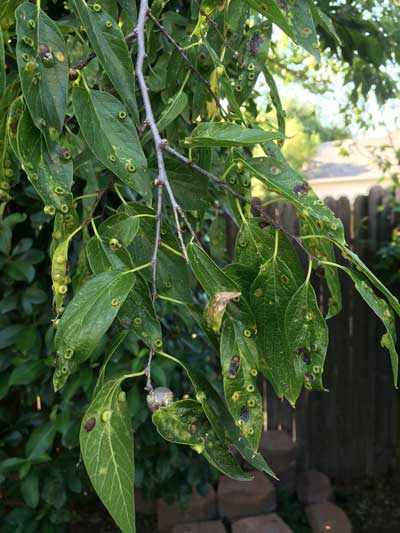
Answer: These are the result of insects. They’re called nipple galls, and they’re caused by small insects that sting the leaves and inject an enzyme into the tissues of the leaves. The leaves produce the warty galls around the developing larvae. It’s all pretty ingenious, and since it’s harmless to the hackberry (your tree), it’s not anything to worry about.
Question: Do you feel that Rose Rosette Virus killed this rose, or could it have been the water curtailments last summer? We have Knock Out roses all through our neighborhood, and RRV seems prevalent. I see signs of the disease on the other two roses, but I’m wondering if we should take them out. How would Indian hawthorns do as replacements? We would like a flowering evergreen. E.S., Frisco.
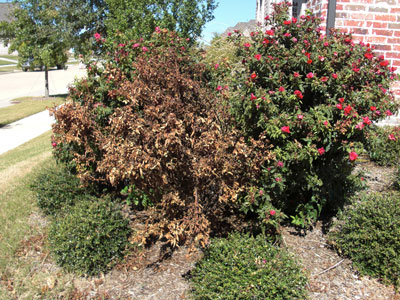
Answer: It was almost assuredly due to Rose Rosette. It has become epidemic in DFW (Frisco), and people need to know that infected plants must be removed entirely (including roots) the minute the disease is detected. The disease is spread by a microscopic mite, and there is no control for it. If plants are left in place for even a few weeks, the mites spread and ruin all roses in nearby landscapes. Trimming the plants back doesn’t help, and homespun remedies using things like hydrogen peroxide won’t work, either. Indian hawthorns are suitable replacements, although they’re susceptible to Entomosporium fungal leaf spot (same disease that has ruined redtip photinias). While they might not be flowering plants, I would choose either Carissa holly or one of the intermediate nandinas. There isn’t a lot of room in that bed. You might even opt to create a color bed in that space. Zinnias, copper plant, firebush and taller lantanas would all be good choices. There are dozens of other good options.
Question: I thought hostas were virtually foolproof, but this summer and early fall, I’ve had lots of browning leaves. What can I do? J.M., no city given.
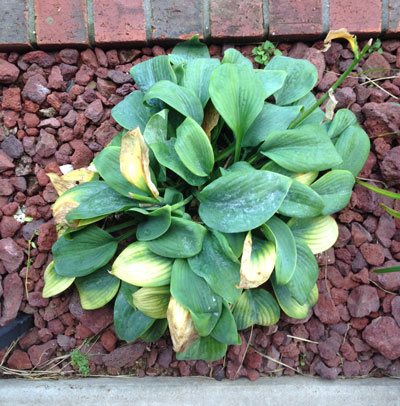
Answer: Hopefully you were aware that hostas, like many perennials, die to the ground each winter, then come back in the spring. They also must have virtually total shade, plus highly organic and moist soils. They’re good in the eastern third of the state (I don’t know where you are.), but they struggle with low humidity near and west of I-35.
Question: I planted several Burford hollies and elaeagnus several months ago. Obviously, the elaeagnus are doing very well, but the hollies are dying. I’ve been faithful about watering. What went wrong with them? S., Valley Mills.
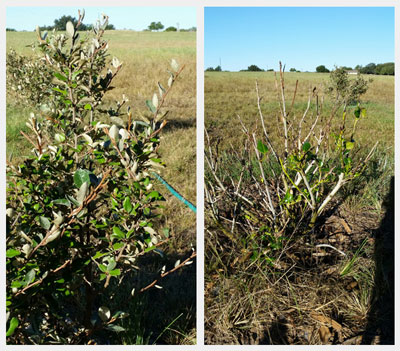
Answer: Elaeagnus are famously more drought-forgiving than hollies. I’m the voice of experience on this one, as my landscape is made up of probably 60 or 70 percent hollies, of 30 or more types. They can get too dry without our even noticing. The plants simply do not wilt unless they have soft new growth on them. The holly in your photo got too dry one or more times. There is absolutely nothing else that will yield that result. I’ve done it several times, so I remember all too well.
Question: I have well-established cannas down the north side of my home. This year something attacked them and devoured their leaves. What would have done this, and how can I stop it next year? K.M., Allen.
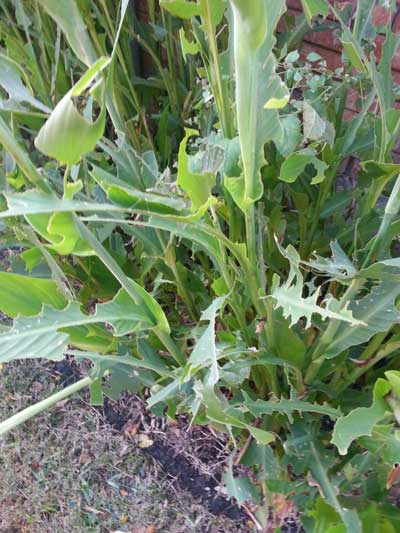
Answer: This almost has to be grasshoppers. They must have moved in like fighter jets, dined, then left. I would not expect this to recur each year if you’re in an urban environment. Near farm fields would be a different story. They probably moved in because of the ongoing Metroplex drought. You will have to use a general-purpose insecticide that lists grasshoppers on its label. Watch every day or two next summer. There is nothing to be done now other than tidying up the bed.
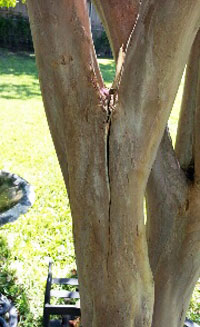 Question: The storm in early October cracked my crape myrtle’s trunk. Can it be saved? S.H., no city given.
Question: The storm in early October cracked my crape myrtle’s trunk. Can it be saved? S.H., no city given.
Answer: Probably so. Drill through the trunk at right angles to the crack with a long 1/4-inch bit. You would probably want to do so just above the spot where it begins to widen out as the crotch is formed. Insert all-thread rod of the same diameter by tapping it through gently. (It would probably be better if you would cut the rod to 3 inches longer than necessary before you tried to insert it, then run a nut and a washer up to the cut end. Cutting the rod can damage the threads and make it difficult to get a nut in place from that end.)
Hammer against the nut, so you’re not wrecking the threading. Once you have it in place with the washer tightly against the trunk, put another washer and nut on the other end and tighten them down.
Since I can’t see the top of the plant, I don’t know whether to advise cabling between the two branches, but if you do so, it ought to be 20 to 24 inches up the branches. Again, drill completely through each branch and insert a threaded eye-bolt. Draw the two branches together gently, then install cable and cable clamps so that the cable is taut. As you release the pressure, the cable will draw even more taut, and that’s good. Do not wrap anything around the trunk or branches, other than what you need to pull them together temporarily.
Question: I have a ‘Bright ‘n Tight’ cherry laurel that was planted last spring. It has had yellowed leaves from late spring until fall. Is this iron deficiency? Too much or too little water? N.M., no city given.
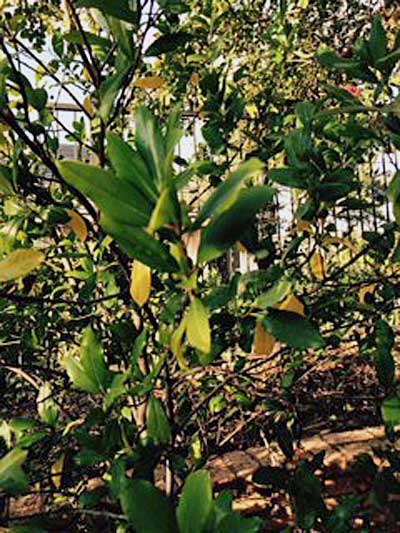
Answer: I zoomed in on your photo as best I could. From all I can see, this is not too much water (wilting, even though the soil is wet), nor is it iron deficiency (yellowed leaves on the newest growth at the ends of the branches – dark green veins, but yellowed blades). This plant looks like it has gotten too dry. Without knowing where you are, it’s difficult to assess how good the plant is for your area. Cherry laurels in general need acidic soils, which is why they do best in East Texas.
Question: What might be going wrong with my crape myrtles? I planted them 15 months ago, and their bark is peeling off in big chunks. M.F., Oak Hill.
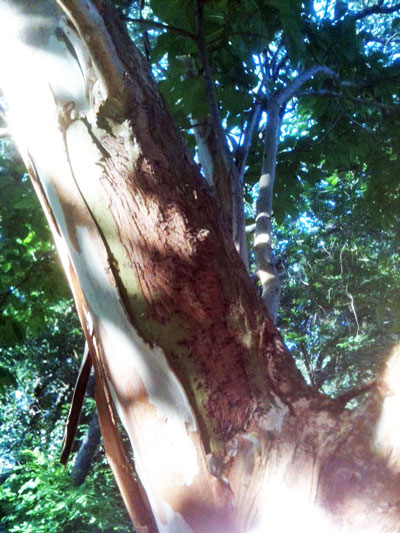
Answer: Bark does peel normally from crape myrtle trunks, just as it does from sycamores and paper birch. However, I do see the discolored internal wood within the branch, and it’s not something with which I’m instantly familiar. It almost looks like scar tissue that has tried to heal, possibly after damage from abrading of another branch (not likely due to placement), squirrels or even cold injury. I just can’t tell for sure. It might help to see the rest of the plant. If you feel the problem merits it, you might want to have a certified arborist take a look at the plant on-site.
Question: I had a local nursery plant this Lacey oak 15 months ago. Just a couple of weeks ago its leaves started to turn brown. I had applied Image a few weeks earlier, and it does seem to be causing the grass to turn yellow, as the label said it would do. Did the chemical do this damage to the oak? What can I do? T.C., Weatherford.
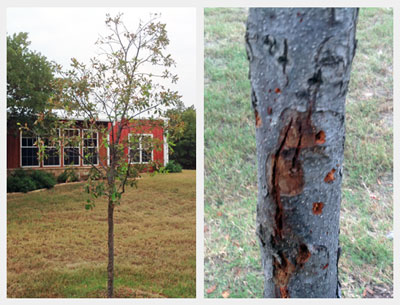
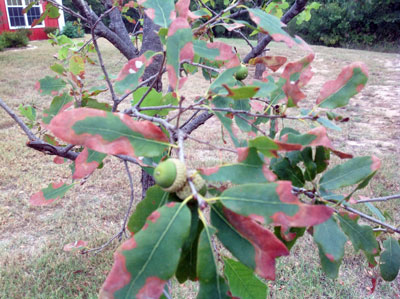
Answer: Image is now more than just a single product, so I would need more facts to give a good answer. It’s a family of products, and some of their active ingredients are capable of doing damage to trees. However, the trunk looks like it’s been hit by borers. It also looks like it might be struggling with damage done by sunscald. If you decide to replace it with another Lacey oak (lovely tree), I’d suggest wrapping the new tree’s trunk with paper tree wrap for the first couple of years. You might want to get the advice of the nursery folks who planted it. I don’t believe any of this falls back to them, but they’ll be a good source of help for you.
Question: I lost a plum tree earlier this summer. It was healthy, then dead two weeks later. Now this young apple next to it looks bad, too. Is there anything I can do? J.S., no city given.
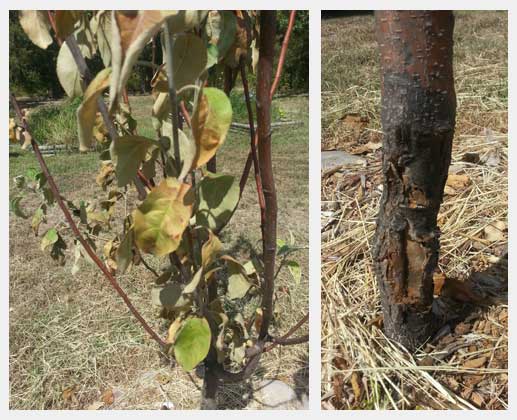
Answer: The trunk looks really bad. I can’t tell what caused it, but it could have been damaged by a mower or other equipment wheel. If the damage were more concentrated at one lower level on the trunk, I would suspect trimmer damage.
Question: I heard the gentleman from the Fort Worth Botanic Garden talking about banana shrub (not true banana) and its fragrant flowers. I ordered 10 of them and planted them this spring, but they have not had any flowers. I have them in various amounts of sunlight, but no blooms. Any advice? P.H., Ponder TX.
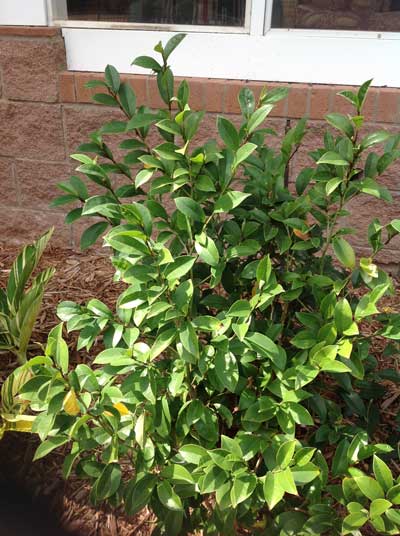
Answer: That’s Michellia fuscata. It’s a lovely shrub, and it produces fragrant flowers once the plants begin to mature (certainly not the first year). However, it will need winter protection in Ponder during extreme cold spells, and it requires acidic soil. I hope your plants do well for you. The botanic garden has theirs in fairly warm spots out of winter winds.
Question: I received two trees (bur oak and redbud) from the Arbor Day Foundation last fall. Are these branching patterns normal? K.F., Shady Shores.
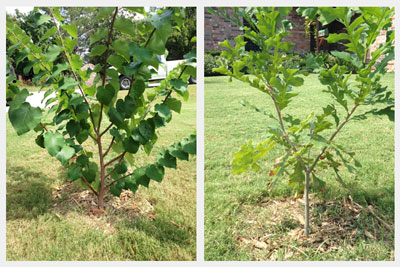
Answer: The redbud looks completely normal. You’ll want to remove a few of the lowest branches over this winter and more a year or so later. But this kind of zig-zag branching is normal for redbuds. I’m less sure what to advise you with the bur oak. Obviously it has two dominant branches/trunks where it should have only one. You could remove the one at the greater angle and stake the remaining one, or if you have to, you could remove the one at the larger angle, then trim the other one back to within an inch or two of the crotch. New shoots will sprout out. Save the straightest new sprout, and clip off the others. Stake it to give it added protection. As the trunk grows in girth, it will absorb any small angle that is left from all this trimming and will grow into a nice, straight tree. It’s imperative that this redirecting be done before spring growth begins, however.
Question: I need privacy from the neighbor’s two-story house, but the wax myrtles and Texas mountain laurels I’ve used aren’t doing very well. I need something between 7 and 14 feet tall. I know hollies would be good, but they’re so overused. What would you suggest? C.M., Colleyville.
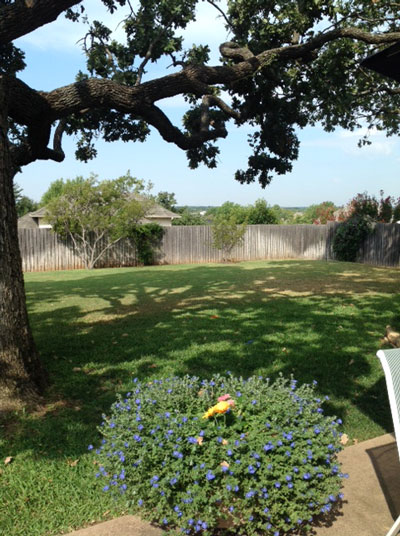
Answer: Very pretty setting. However, you’re asking a guy who has hollies all over his landscape! They are my go-to landscape plants, and the reason for that is because they are so very well adapted to Texas soils and climate. Mountain laurels are lovely, but they’re not completely winter-hardy in DFW. You may have seen my commentaries about wax myrtles and the fact that I have them on my own internal “don’t ever plant again” list. They live for a few years in Metroplex conditions (where you and I both live), then they start dying one branch at a time until they finally break your heart. I would consider, in order: Nellie R. Stevens holly, Oakland holly, female yaupon holly (so I would get berries), willowleaf holly (will grow to 8 feet tall) and then, I guess, waxleaf ligustrum, glossy abelia or elaeagnus.
Question: We have St. Augustine, and we have successfully battled nutsedge by carefully digging it out by hand. However, this year, this weed has appeared. We are limited in using herbicides due to our trees. What can we do? S.M., Mansfield.
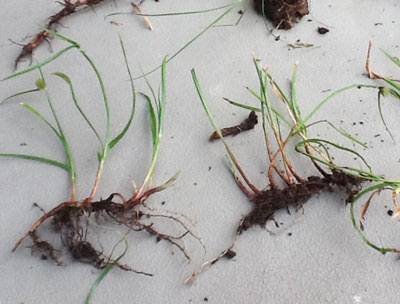
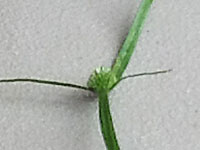 Answer: Best I can tell, this is also a sedge. Cut one of the stems straight across with a very sharp knife. If what’s left after the cut is a triangular stem, that’s a sedge. If it’s round, it’s a grass. Since I’m pretty sure it’s a sedge, I’m going to suggest you ask your nurseryman for either Sedgehammer or the original Image that was developed specifically and only for sedges. There are other products now within the Image line, so get help in making your choice.
Answer: Best I can tell, this is also a sedge. Cut one of the stems straight across with a very sharp knife. If what’s left after the cut is a triangular stem, that’s a sedge. If it’s round, it’s a grass. Since I’m pretty sure it’s a sedge, I’m going to suggest you ask your nurseryman for either Sedgehammer or the original Image that was developed specifically and only for sedges. There are other products now within the Image line, so get help in making your choice.
Question: I have these brown spots in my St. Augustine. They’re right next to healthy grass, and there are many of them. What should I do? D.S., no city given.
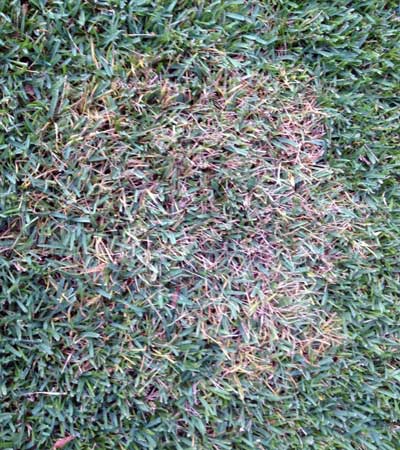
Answer: This is a disease known as brown patch. It shows up almost every fall once temperatures drop and especially after rains. Here is what I have in the FAQ section of my website: https://neilsperry.com/faq/5145/
Question: I have ‘Tonto’ crape myrtles. They haven’t done well following last winter. I know I shouldn’t top them, but there is enough dead growth that I’m wondering what I should do. B.B., Parker County.
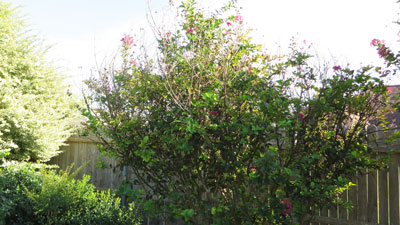
Answer: If you’re removing dead growth, that doesn’t qualify as “topping.” Nor does removing green and normal growth when you have to do so to reshape a damaged plant. Trim out all of the dead wood before the plants are bare for the winter, then reshape the plants as needed this winter, when you can see through their canopies. You’ll probably want to take out a lot of the extra stubble in the process. Use lopping shears, and make all cuts flush with remaining limbs. It’s when people leave big stubs on crape myrtle trunks and branches that they end up topping their plants.
Question: I have two lawns, one bermuda and one St. Augustine. Both are being invaded by this grass. Is this K.R. bluestem? How can I eliminate it? I have neighbors using MSMA, but I thought it was gone from the market. D.L, St. Paul, TX.
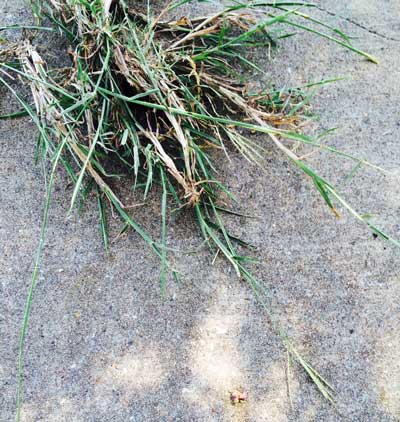
Answer: Yes, this is K.R. bluestem. Brought in as a forage grass, it has overpowered much of our Texas turf and pasture grasses. Look it up online, and you’ll find a variety of posts. Some are favorable to it as a pasture grass, while those of us in horticulture do not like it at all. MSMA is not available at the consumer level. Your neighbors must be buying it some other way. The best way I can recommend to eliminate K.R. bluestem is by taking ultimate care of the bermuda and St. Augustine: frequent mowing and regular feeding and watering.
